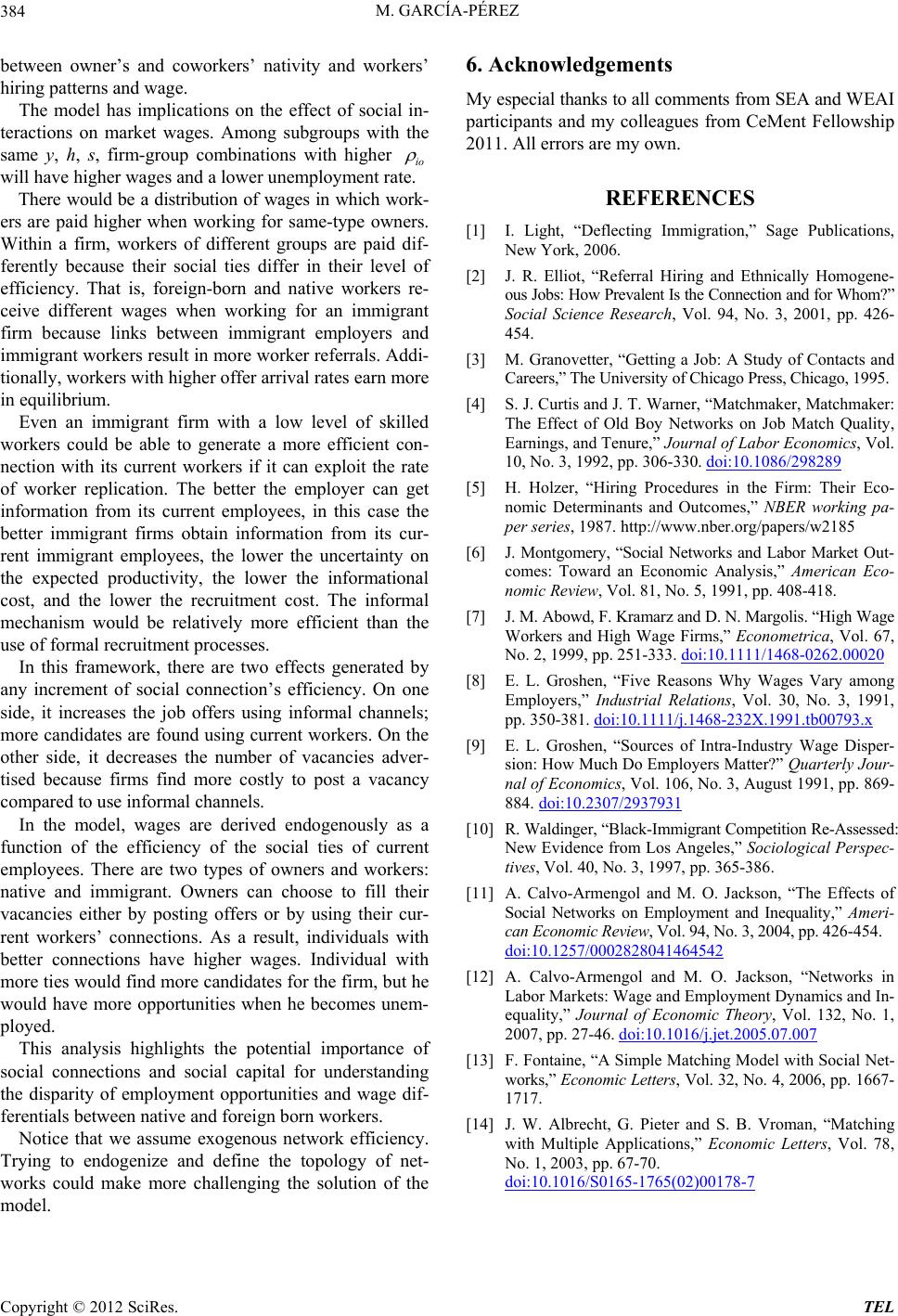
M. GARCÍA-PÉREZ
Copyright © 2012 SciRes. TEL
384
’ nativity and workers’ 6. Acknowledgements
My espe
between owner’s and coworkers
hiring patterns and wage.
The model has implications on the effect of social in-
teractions on market wages. Among subgroups with the
same y, h, s, firm-group combinations with higher
cial thanks to all comments fro m SEA and WEA I
om CeMent Fellowship
[1] I. Light, “Deflecting Immigration,” Sage Publications,
New York, 20
[2] J. R. Elliot, “nically Homogene-
arch, Vol. 94, No. 3, 2001, pp. 426-
urtis and J. T. Warner, “Matchmaker, Matchmaker:
participants and my colleagues fr
2011. All errors are my own.
io
will have higher wages and a lower unem ployment rate.
There would be a distribution of wages in which work-
ers are paid higher when working for same-type owners.
Within a firm, workers of different groups are paid dif-
fer
REFERENCES
06.
Referral Hiring and Eth
ently because their social ties differ in their level of
efficiency. That is, foreign-born and native workers re-
ceive different wages when working for an immigrant
firm because links between immigrant employers and
immigrant work ers result in more w orker referrals. Add i-
tionally, workers with higher offer arrival rates earn more
in equilibrium.
Even an immigrant firm with a low level of skilled
workers could be able to generate a more efficient con-
nection with its current workers if it can exploit the rate
of
ous Jobs: How Prevalent Is the Connection and for Whom?”
Social Science Rese
454.
[3] M. Granovetter, “Getting a Job: A Study of Contacts and
Careers,” The University of Chicago Press, Chicago, 1995.
[4] S. J. C
The Effect of Old Boy Networks on Job Match Quality,
Earnings, and Tenure,” Journal of Labor Economics, Vol.
10, No. 3, 1992, pp. 306-330. doi:10.1086/298289
[5] H. Holzer, “Hiring Procedures in the Firm: Their Eco-
nomic Determinants and Outcomes,” NBER working pa-
per series, 1987. http://www.nber.org/papers/w2185
worker replication. The better the employer can get
information from its current employees, in this case the
better immigrant firms obtain information from its cur-
rent immigrant employees, the lower the uncertainty on
the expected productivity, the lower the informational
cost, and the lower the recruitment cost. The informal
mechanism would be relatively more efficient than the
use of formal recruitment processes.
In this framework, there are two effects generated by
any increment of social connection’s efficiency. On one
side, it increases the job offers using informal channels;
mo
0020
[6] J. Montgomery, “Social Networks and Labor Market Out-
comes: Toward an Economic Analysis,” American Eco-
nomic Review, Vol. 81, No. 5, 1991, pp. 408-418.
[7] J. M. Abowd, F. Kramarz and D. N. Margolis. “Hi gh Wage
Workers and High Wage Firms,” Econometrica, Vol. 67,
No. 2, 1999, pp. 251-333. doi:10.1111/1468-0262.0
[8] E. L. Groshen, “Five Reasons Why Wages Vary among
Employers,” Industrial Relations, Vol. 30, No. 3, 1991,
pp. 350-381. doi:10.1111/j.1468-232X.1991.tb00793.x
re candidates are found using current workers. On the
other side, it decreases the number of vacancies adver-
tised because firms find more costly to post a vacancy
compared to use informal channels.
In the model, wages are derived endogenously as a
function of the efficiency of the social ties of current
employees. There are two types of owners and workers:
na
[9] E. L. Groshen, “Sources of Intra-Industry Wage Disper-
sion: How Much Do Employers Matter?” Quarterly Jour-
nal of Economics, Vol. 106, No. 3, August 1991, pp. 869-
884. doi:10.2307/2937931
[10] R. Waldinger, “Black-Immigrant Competition Re-Assessed:
New Evidence from Los Angeles,” Sociological Perspec-
tives, Vol. 40, No. 3, 1997, pp. 365-386.
4, pp. 426-454.
tive and immigrant. Owners can choose to fill their
vacancies either by posting offers or by using their cur-
rent workers’ connections. As a result, individuals with
better connections have higher wages. Individual with
more ties would find more candidates for the firm, but he
would have more opportunities when he becomes unem-
ployed.
This analysis highlights the potential importance of
social connections and social capital for understanding
the disparity of employment opportunities and wage dif-
fer
[11] A. Calvo-Armengol and M. O. Jackson, “The Effects of
Social Networks on Employment and Inequality,” Ameri-
can Economic Review, Vol. 94, No. 3, 200
doi:10.1257/0002828041464542
[12] A. Calvo-Armengol and M. O. Jackson, “Networks in
Labor Markets: Wage and Employment Dynamics and In-
equality,” Journal of Economic Theory, Vol. 132, No. 1,
2007, pp. 27-46. doi:10.1016/j.jet.2005.07.007
[13] F. Fontaine, “A Simple Matching Model with Social Net-
works,” Economic Letters, Vol. 32, No. 4, 2006, pp. 1667-
1717.
entials between native and foreign bor n w or ker s .
Notice that we assume exogenous network efficiency.
Trying to endogenize and define the topology of net-
works could make more challenging the solution of the
model.
[14] J. W. Albrecht, G. Pieter and S. B. Vroman, “Matching
with Multiple Applications,” Economic Letters, Vol. 78,
No. 1, 20 03, pp. 67-70.
doi:10.1016/S0165-1765(02)00178-7